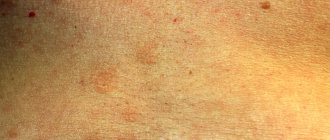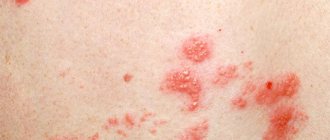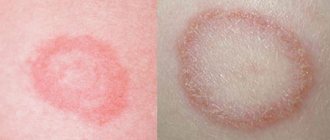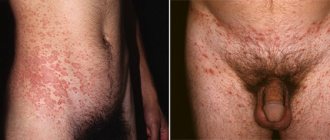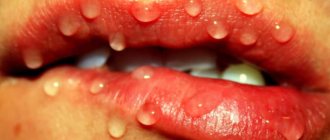Symptoms
The disease manifests itself in the form of spots on the skin.
First, several so-called maternal formations about 5 cm in size appear. Then, over the course of a week, a large number of similar spots of smaller sizes scatter throughout the body. The most vulnerable areas are the abdomen, shoulders and hips. Rashes are rare on the face and neck. All spots, both maternal and “baby” ones, have the same appearance: pink or with a yellowish tint, round in shape, flaky inside with a smooth rim. Often, apart from spots, this disease does not manifest itself in any way. Therefore, as soon as any characteristic formations are discovered on the body, you should immediately contact a special clinic to diagnose pityriasis rosea. Sometimes itching appears in the affected areas, and the lymph nodes on the neck and chin become enlarged. If a person’s immunity is severely weakened, severe fatigue, fever or general intoxication of the whole body appears. There are cases when the external manifestation differs from the usual: blisters or white nodules appear on the skin.
Pityriasis versicolor (tinea versicolor): symptoms
The disease is characterized by the following symptoms:
- the appearance of spots of different shapes, sizes (usually with uneven edges) and colors (white, red, brown, etc.);
- the spots become scaly and may sometimes itch;
- under the influence of the sun, spots can change color and intensity;
- as the disease progresses, the spots increase and unite into large groups;
- Sometimes, if the source of the spot is the scalp, the hair may fall out.
Localization of spots is the chest, back, groin area, arms, legs, less often the face, scalp and genitals. The incubation period ranges from two weeks to several months; in children, the first signs may appear earlier.
Pityriasis versicolor (colored, multi-colored or solar) lichen: causes of occurrence
The main cause of the disease is a fungus that gets on human skin. But there may be several factors that can provoke the active proliferation of this fungus and the appearance of such characteristic symptoms of pityriasis versicolor as multi-colored spots:
- individual (genetic) predisposition to dermatomycosis;
- skin type and/or disruption of the normal functioning of the stratum corneum;
- the presence of concomitant diseases of the endocrine system;
- diabetes mellitus, excess weight, vegetoneurosis;
- increased sweating;
- reduced immunity;
- chronic diseases;
- vegetative-vascular dystonia;
- diseases of the gastrointestinal tract, as well as liver and pancreas;
- respiratory diseases;
- severe stress and constant nervous tension;
- frequent changes in climate and time zones;
- uncontrolled use of medications and cosmetics that are unsuitable for your skin type;
- disturbances of hormonal levels and the functioning of the genitourinary system in women.
The reasons may also be external factors: hot weather or the use of antibacterial personal hygiene products (gels, creams, etc.). But, whatever the cause and no matter how the disease develops, if there are signs of any intensity, you should consult a doctor.
When contracting any skin disease, it is very important to treat not the symptoms, but the causes, while simultaneously getting rid of the existing factors that provoke the disease. This type of lichen may not go away for a long time, and accordingly, treatment may take a long time.
How to treat solar lichen (colored, pityriasis versicolor, multi-colored) and cure it, securing the result for a long time, dermatologists
medical
Modern diagnostic methods make it possible to get rid of the disease and prevent its relapses. An individual course is selected for each patient and maximum attention is paid during treatment to ensure comfort in the fight against an unpleasant disease.
Initial appointment
The initial appointment is an examination, studying tests and complaints to identify the causes that led to infection, as well as drawing up a general clinical picture. In some cases, already at the first consultation, the doctor can prescribe treatment and recommend a course of restorative procedures.
But if the case has any deviations or complications, then it is necessary to prescribe additional studies and consultations with other specialists.
Diagnostics includes:
- skin scraping examination;
- examination of the skin using a Wood's lamp;
- consultations and examinations with specialists such as a gastroenterologist
,
gastroenterologist
and psychotherapist; - examination of the skin using an iodine test.
What exactly the doctor will prescribe and whether any additional research will be needed depends solely on each specific case, as well as the selected methods and drugs for the treatment of pityriasis versicolor (tinea versicolor, solar lichen) in an adult or in children.
Treatment plan
If a course of treatment was prescribed at the patient’s first meeting with the doctor, then at the secondary appointment the doctor assesses the patient’s condition and the effectiveness of the prescribed regimen.
If the selected regimen and drugs for the treatment of pityriasis versicolor (variegated, colored) lichen do not work, then the doctor can either prescribe an additional examination or adjust the previously prescribed course. The doctor also draws up a treatment plan with an individual schedule for subsequent visits.
What can be included in the course of treatment?
Most often, the doctor prescribes:
- antifungal drugs;
- antifungal ointments and gels;
- special shampoos if lesions are found on the scalp;
- antibiotics from the tetracycline group for severe forms;
- topical products with exfoliating and anti-inflammatory effects.
During treatment, it is very important to strictly follow all the doctor’s instructions (take medications on schedule and in the right quantity, follow established rules, etc.), but remember that any deterioration or abnormal reaction of the body must be reported to the doctor so that he can adjust treatment.
Control reception
A follow-up visit to the attending physician's office is scheduled 21–30 days after the start of treatment. This is necessary to assess the patient’s condition after the main course and prescribe a number of restorative and preventive measures. Such measures may include physical therapy, restoration of gastrointestinal microflora, nutritional correction, etc.
Treatment result
The disease can be cured, but the timing of treatment and recovery is individual and is discussed at a doctor’s appointment. Also, if necessary, the doctor prescribes consultations and examinations for all family members, since infections could have occurred through personal hygiene items.
Prevention
A good prevention of this skin disease is:
- observing simple hygiene rules in public places (swimming pools, gyms, etc.);
- maintaining personal hygiene. Personal hygiene items can and should not only be changed frequently, but also constantly disinfected;
- ironing clothes after washing and before wearing (especially for children's underwear and clothes);
- wearing and using clothing and personal hygiene items only from natural materials of good quality;
- temporary avoidance of prolonged exposure to the sun;
- nutrition correction;
- hardening and dousing with acidified water;
- taking vitamins or vitamin complexes;
- compliance with sanitary standards in the apartment and in the workplace;
- individual selection of cosmetic skin care products;
- normal healthy sleep;
- a properly selected system of physical activity and sports to strengthen the immune system and increase the body’s resistance to external influences.
It is also important to exclude all causes that have led or may lead to a recurrence of pityriasis versicolor (colored, multicolored, solar) lichen. Compliance with minimum standards and taking care of your health will significantly reduce the risk of the return of this unpleasant skin disease, and will also bring your psychological state back to normal.
If the disease returns even after treatment and all the measures taken, then it’s time to think about a serious examination by a group of specialists, since inflammation of the skin may be a consequence of diseases that did not manifest themselves in any way before.
To make an appointment for a consultation or appointment with one of the medical dermatologists, you can use a special online form on the website or the phone number listed at the top of this page.
Methods of infection
To date, there is no consensus on the methods of infection.
There is an assumption that the source of the disease is the herpes virus and that people with low immunity, those who have recently suffered viral infections, colds, and who are often hypothermic are primarily at risk of contracting Zhiber's disease. Women and children have a significantly higher risk of infection than men. Observations show that people over 40 years of age and infants practically do not become infected with this infection. Is this disease contagious? There is no clear answer to this question. There is an opinion that it can be transmitted through tactile contact or airborne droplets. A prerequisite for a person to become infected is the presence of a provoking factor. In practice, it has been noted that transmission of this virus from one person to another occurs infrequently.
Ringworm in humans: causes and types
This pathology is related to the skin. It is observed in both adults and children of any age. Most often, the disease is contagious, so people with weak immune systems are especially at risk.
Ringworm can be transmitted from cats, dogs and other infected animals. But this disease may have other causes:
- weakened immunity due to previous infection;
- frequent psychological stress, stress;
- violation of personal hygiene rules;
- poor environmental conditions;
- disorders of the nervous system;
- disruptions in the hormonal system.
Depending on the causes and manifestations in humans, there are 7 types of lichen:
- Shingles: occurs against the background of an exacerbation of the herpes virus. It appears as spots on the intercostal area, next to the main nerve pathways. May not show any symptoms for 2 or 3 weeks. The ocular variety is especially dangerous, since in this case, if left untreated, you can lose your vision.
- Ringworm (also called trichophytosis) affects the skin of the head, neck, and shoulder area. Often observed in children. The disease is caused by fungi and occurs due to infection from a sick person or animal (contact-household route).
- Pink, which is also called Gibert's disease, occurs due to the herpes virus, mainly in spring and autumn. Characterized by pink spots on the limbs and groin area.
- Pityriasis develops due to microscopic fungi, mainly in the summer. As a result, spots of different colors appear on the skin - pink, yellow, brown. There is no inflammation, but the skin is peeling. It very often affects the back. If nothing is done, this form can become chronic.
- Lichen planus is a rare type of lichen that develops on the mucous membranes of different parts of the body, in the mouth, on the forearm and limbs. If left untreated, it can completely destroy the nails.
- White (also called solar) is the weakest form of lichen, which can develop over several years. The cause of the appearance is infection with yeast fungi. Most often it affects children and young people under 30 years of age. Mainly affects the skin surfaces of the chest and scalp. This form has nothing to do with the sun, but the white spots are clearly visible against the background of a tan, which explains the name of the disease.
- Scaly (second name is psoriasis) is a non-infectious lichen associated with autoimmune processes. A dangerous form that, if left untreated, can lead to arthritis.
Treatment
Only a qualified specialist can determine what exactly a person has become infected with.
First a visual inspection is carried out. However, this is not enough. This type of disease looks very similar to psoriasis, rubella or syphilitic roseola. To accurately diagnose and prescribe the correct treatment for lichen, the clinic prescribes a blood and urine test, takes a scraping, and the patient undergoes a special test. Gibert's disease does not require particularly complex treatment. The disease goes away in six to nine weeks. The spots gradually fade and stop peeling. For some time, marks remain on the skin, but they also disappear over time. To alleviate the symptoms, the doctor prescribes treatment: to relieve itching - antihistamines, to reduce peeling - various ointments. Multivitamin complexes are also prescribed to increase the patient’s immunity.
In addition to drug treatment of pityriasis rosea, a hypoallergenic diet is prescribed. All foods that can cause allergic reactions are excluded from the diet: citrus fruits, eggs, red fruits, chocolate, coffee, alcohol, honey, nuts.
It is also necessary to exclude physical activity, passing exams, limit communication in order to avoid getting into stressful situations, try to wear clothes made from natural fabrics, and wash only in the shower with mild detergents. It is also forbidden to expose the affected areas of the skin to direct sunlight, as this increases the peeling process and, accordingly, impedes healing. Any self-medication can lead to undesirable consequences, so consultation with a specialist is necessary.
How to avoid infection
Due to the fact that the nature of the occurrence of Gibert's disease has not been thoroughly studied, there are no methods to prevent this disease. The main recommendation is to monitor the state of the immune system, as it will help avoid infection.
Complications
The disease itself in most cases goes away without leaving a trace. However, sometimes complications arise in the form of eczema, staphylococcus or streptococcus; ring-shaped lichen can develop, which quite often becomes chronic and even after a few years a relapse can occur. Then treatment is done with antibiotics. To prevent such problems, we strongly recommend that you undergo comprehensive treatment in our clinic. Don't forget about your health and the health of your family!
Primary sources of development of pityriasis rosea
The disease most often occurs in the autumn-spring period and differs in seasonality. It is registered in patients from 20 to 40 years old, sometimes found in children under 10 years old or elderly patients, pregnant women. After recovery, people develop lasting immunity to the disease.
The exact reasons for the development of pityriasis rosea are unknown; there is a theory about the viral origin of the pathology. Some scientists are inclined to believe that the disease appears when infected with the seventh type of herpetic infection.
Risk factors for the formation of lichen Zhiber include disruption of the immune system that occurs after a cold: acute respiratory viral infections, acute respiratory infections. Unstable immunity is the main source of impaired protective functions; the problem can cause a secondary infection to join the pathology, which will lead to an increase in recovery time.
